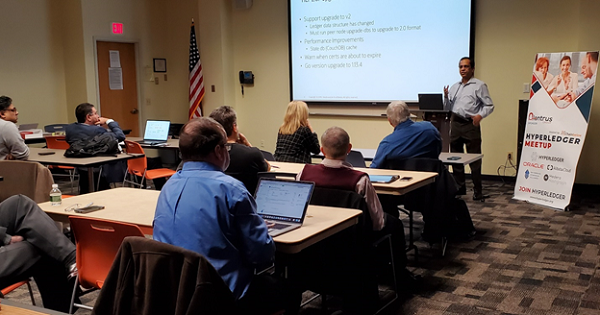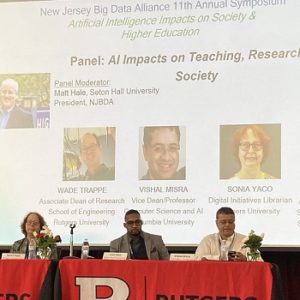Henry’s Take: So, I went to a Hyperledger Meetup. What the hell is that?
On February 26th, I attended the Hyperledger Morristown Meetup at the Morris County Library. The place was very impressive. I passed by a ton of amazing books and entered a meeting room filled with equally amazing people. After we were graciously welcomed by one of the organizers, Roman Anderson, they got right down to business.
Now, before I dive into talking about the event, you are probably wondering, “What is Hyperledger, and why is he writing about it?” Frankly, about eight months ago, I would have been asking the same question. OK, I am lying a bit, but once I saw the agenda, I hit the web and started refreshing myself on the subject. Here was the meeting agenda:
- Hyperledger 2.0 release and Global Update
- Oracle – Blockchain Platform and Roadmap
- Enterprise Ethereum Alliance – Introduction and Updates
- Alibaba Cloud – Newest Release – ECS Gen 6 with Kubernetes
- DataKNOX – Alontrus Group Demo of DLT Engine Running on ECS 6
- Hedera Hashgraph – Boost – Their New Platform to Launch and Grow Startups
I am not going to try to teach you about blockchain. There is plenty of stuff on the web for that. I will, however, try to convince you of why you should start paying more attention to it. Please note that blockchain comprises blocks of data chained together, and it’s a type of distributed ledger technology (DLT). There is much more to DLT, but for the purpose of this article, I will use the terms “DLT” and “blockchain” interchangeably.
Now, if you go back to the agenda, it will hopefully make more sense to you. All of the topics relate to the phenomenal growth of the DLT (blockchain) ecosystem. In other words, blockchain is beginning to crawl out of the ocean, and is starting to walk on all four legs. (Ugh, I know that was bad).
Hyperledger
I do need to explain what Hyperledger is, as it’s in the name of the group. Hyperledger is an open-source collaborative effort created to advance cross-industry blockchain technologies. This still may mean nothing to you, but let’s focus this key term: “open source.” It has grown to the point where it now has the backing of some of the most prominent companies in the world. Below, I mention a few of their premier members, all of whom offer products and services on the platform.
For example, Deepak Goel, senior director of software development for the Oracle Blockchain Platform, spoke at length about the Oracle blockchain road map for 2020. After about 40 minutes of speaking, he was actually surprised when he was told that he had three minutes left. He could have gone on for another hour. The coolest thing about the road map is how easy Oracle makes it to get into DLT, to overcome the hurdles to entry that you may have heard about.
The Alibaba Cloud couldn’t let me purchase the knock-off Nike sneakers I wanted, but it did enlighten me on how the whole cloud environment is beginning to get commoditized. Alibaba provides functions similar to those of Amazon Web Services (AWS), but it’s about 40% cheaper. When the presenter asked if anybody had heard of China’s Alibaba Cloud, nobody raised their hands. What’s interesting about Alibaba Cloud is that it provides redundancy all over the world at much lower prices than the traditional guys. It also offers more powerful machines for less and, of course, it supports blockchain. I just wish they’d throw in the sneakers, as well.

DataKNOX from Alontrus Group
Now, the best for last: the DataKNOX guys, from the Alontrus Group (Sparta). The product was created by two gentlemen with completely different backgrounds, Dev Bhattacharyya and Richard Brownstein. Just as the name “DataKNOX” implies, it’s the Fort Knox for your data, leveraging the best characteristics of DLT — immutability, security, decentralization — and I have to say “security” again.
DLT is an excellent choice in this age of cyberattacks. A distributed ledger makes it hard for hackers to access your database. This is because everything is transparent, so it is easy to trace back to the hacker. Also, in order to get into your database, hackers need substantial computational power, which might not be possible for the majority of them out there. Now, before you tell me to hold on a second, did I say transparent? That’s where the KNOX part of the name comes in. Every piece of data is hashed by 512-bit encryption, military-grade, but I am getting ahead of myself.
Think of DataKNOX as a connector for your legacy data that can stream it very fast. It can connect your data to the cloud with blazing speed and security, giving you the ability to leverage any business intelligence/artificial intelligence tools to further extend your workflow and processes. Suppose a patient needs to transfer from one hospital to another. Because of massive cyberattacks, many hospitals are staying off the web. With DataKNOX, however, you can safely transmit the patient’s data from one hospital to the other, leveraging encryption not only in flight but also at rest.
The best part is that the data is encrypted and is stored in a massive DLT database across thousands of nodes all over the world (The “d” in “distributed”). If you ever get hacked, you can feel comfortable, knowing that your data stored in the cloud is 100% real and safe. The beauty of this process is that you can focus on the data, and not on the infrastructure. You don’t need to worry about massive transformational gyrations that today’s cloud providers make you go through. Instead, you focus on your applications and how you can help that patient move seamlessly from one hospital to another, fully knowing that his or her data is completely safe and, more importantly, cryptographically backed up in the cloud.
I walked away from the event very excited, thinking about the 1990s and the growth of the internet since then. In a similar fashion, blockchain development, tools, and products are exploding all over the planet. According to LinkedIn, blockchain is one of the most in-demand job skills in 2020. It is definitely similar to the 1990s, when different technologies rose and fell and eventually coalesced into something that today we cannot live without, for better or for worse. Blockchain is similar: It is exciting, explosive and is fraught with dangerous twists and turns. After all, walking out of the water was just the beginning. Now it’s time to grow some fur.



